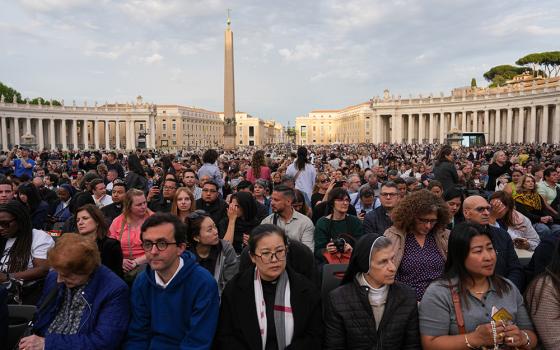
(Unsplash/Justin Ziadeh)
I am always looking for a quiet place. Not in a coffee shop where the din is deafening and the smells are terrific, but a place where I can walk, think and see what is going on inside my own life.
It's not so easy to find one these days. Even church can be a challenge, with those dings and tunes we have become immune to.
Quiet time — and a place for our soul to hear it — has become a basic human need. A need we ignore.
Most days it is quiet in our church's prayer garden, where I sit on a bench and read, pray or just listen to the birds sing. I observe its neglect. Damaged plants, tramped down mulch, dead flowers and wet spots; the place needs a facelift, as so much of our church does.
We realized we were creating a new ministry, terrified by having the responsibilities of caring for our dead, but believing too that having a columbarium in the prayer garden might just add to the prayer life of our church.
I also find quiet walking in cemeteries.
In Iowa, it doesn't take long to find a cemetery. Built on a grid, the entire state is a series of turns. When you hit a gravel road, small churches appear with their cemeteries still in use. Once, a friend and I went rubbing gravestones for her thesis work on the artistic architecture displayed in rural graveyards. As she was off rubbing stones, I stumbled upon a great find: a huge boulder with a bronze plaque.
It told the brief story of a family of six from Ohio killed horribly in 1860 as they crossed the prairie trying to migrate to a new life in Iowa. Their covered wagon was overtaken without warning by a prairie fire as they slept. After the fire had burned off, farmers searched the area to locate their camp. There they found a mother and her four children, burned to death.
The farmers buried what they could find and placed a huge boulder on the site of the tragedy, stones and rocks often used in those days as tombstones for the poor.
But that wasn't the end of the story.
The tragedy was lovingly held within the community's memory until the late 1930s, when they carved out a spot on the rock their ancestors had placed over the victims' grave. There they installed the bronze plaque I stood reading, many decades later.
My eyes scanned the horizon, noticing the vast fields of planted, growing corn, and I suddenly felt awe and a quiet holiness standing there. My feet were planted on holy ground and that holiness surrounded me. It turned this tragedy into triumph.
How could this story suddenly bring tears to my eyes more than 160 years later? The awesome power of it, the holiness I felt, helped me understand how such a place as this is where death and life meet, and life triumphs.
Advertisement
One day, the idea of installing a columbarium — a simple structure with niches to hold the urns of those who have been cremated — in our church's prayer garden was agreed upon. Only a handful of parishioners complained about having a "cemetery" next to the church. Cemeteries still signify death to many who understand life as ending there. I just saw a quiet place to sit.
Then the COVID lockdown hit. The frightening horror of sudden death became more of a reality.
The families of our parishioners who died during COVID began cremation, columbarium ready or not. They held onto their loved one's cremains, waiting patiently for what might still be. The moment a columbarium might arrive, their loved ones could become part of an everlasting community of prayer in the prayer garden.
Round and round the search committee went, facing questions and challenges. Like daffodils blooming in spring, answers were found, and discussion freely flowed about something that would be new and beautiful.
We realized we were creating a new ministry, terrified by having the responsibilities of caring for our dead, but believing too that having a columbarium in the prayer garden might just add to our church's prayer life.
One cold winter day before the columbarium came, I stood in the snow-filled prayer garden beneath a dormant redbud tree listening to the stillness of the fresh blanket of snow. Perfect quiet. Perfect peace.
But then the bell rang for recess. Hearing chattering on the far side of the building, I could see the kids file out, running, throwing balls, hanging upside down on the gym equipment as others rolled in the snow.
Perfect peace was gone.
The following spring, the columbarium arrived and was set in place, looking as if it had been there for years. People who saw it there came away smiling.
Instead of perceiving it as a representation of death, parishioners began to linger more often in the prayer garden, filling it with joy and holiness and new life.
Now it is no longer just a prayer garden. The community holds it, enjoys it, prays there, as it fills with the communion of our saints who intercede for us.
It will be a place of our memories, a place where death and life meet. And one thing more, too: perfect joy.




